by Lisa Cooke | Jun 21, 2017 | 01 What's New, Health History, MyHeritage
There’s an easy, free way to analyze your family tree for patterns! Discover your ancestors’ average life expectancy, most common first names, how long they stayed married, and more. Share the results at your next family reunion, or use them to understand your family health history just a little bit better. Here’s how.
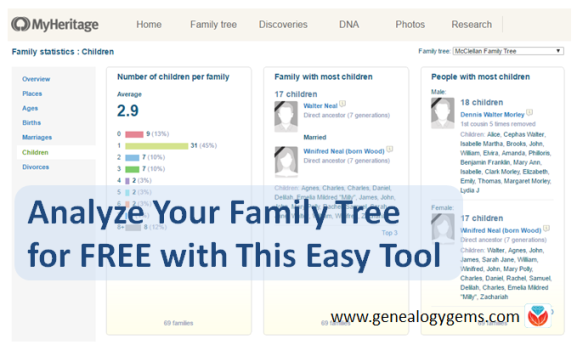
Whether you’re a paying subscriber to MyHeritage or are signed up as a free user, you have access to a little-known but fascinating tool on the site: Family Statistics.
You’ll find this tool under the Home tab:

Use this tool to explore various statistics and patterns in your family history, and to spot the “record-holders” on your tree. You don’t have to enter any information. Just click the topic on the left that you want to view (overview, places, ages, births, marriages, children, divorce). Easy-to-read infographics and summary charts will appear:
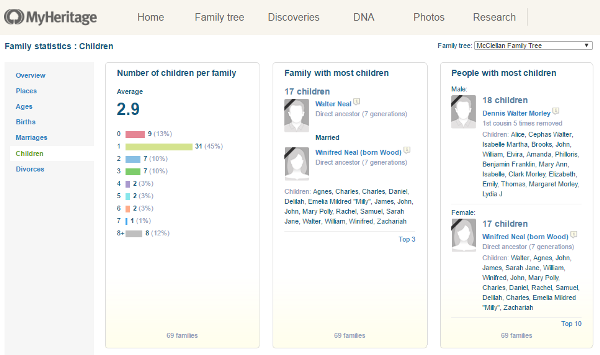
The Family Statistics tool will tell you:
- the most common places of birth, death, and residence
- most common surnames and male/female first names
- average life expectancy for men and women
- longest-lived and shortest-lived ancestors
- oldest/youngest living relatives on tree
- most common birth month, and how many people were born in each month
- number of marriages, and the longest and shortest marriages
- age at first marriage and who was the youngest/oldest when they married
- the biggest age differences in a couple
- total number of divorces, as well as the average age (and oldest/youngest) age at divorce, and the longest marriage ending in divorce
- average number of children per family and people with the most children
- the youngest/oldest age when having a child
- the average and biggest/smallest age difference between oldest and youngest children
You can run these statistics for all your trees together or individually. Here are some of the different ways to use the data:
For your research: Watch for possible errors or omissions on your family tree. Do you really have a relative who lived to be 112 years old, or did someone neglect to enter a death date?
For fun: Watch for interesting things to share in a trivia game or quiz at your next family reunion. You might even consider creating a “Hall of Fame” for that great-grandfather who lived to be 103, or that great-aunt who had 14 children. (Remember, don’t embarrass anyone by sharing sensitive or confidential information about living relatives or the recently-deceased.)
For understanding: Do certain patterns tend to run in your family, such as having children at a younger or older age?
For family health history: Longevity–age at death–is a measure in Family Statistics that relates to your family health history. You can’t look at cause of death with this tool, but click here to read about a clever way to look at causes of death in your family.
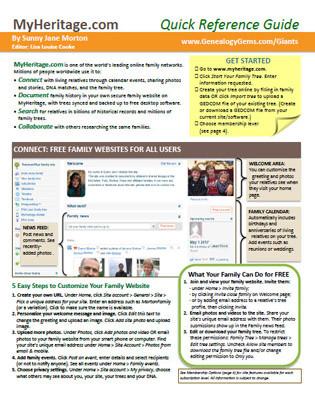 MyHeritage is known for the technology tools on its site, such as its new Collection Catalog, the Discoveries pages, its DNA matching (click here to upload your raw data for FREE!), automatic record matching in unindexed content such as books, and automatic name translation in the search function.
MyHeritage is known for the technology tools on its site, such as its new Collection Catalog, the Discoveries pages, its DNA matching (click here to upload your raw data for FREE!), automatic record matching in unindexed content such as books, and automatic name translation in the search function.
Get up to speed on what MyHeritage has to offer in our totally-affordable MyHeritage Quick Guide, newly updated for 2017! Also check out our brand new quick guide, Genealogy Giants: Comparing the 4 Major Websites Quick Guide, which compares MyHeritage to what you’ll find on Ancestry, FamilySearch and Findmypast. Each has fantastic features you’ll want to know about!

by Lisa Cooke | Jul 20, 2016 | 01 What's New, Immigration |

Traveling ancestors created records when they left the country of their origin and when they arrived at their new residence. We often talk about immigration, with an I, but have you researched your ancestors emigration records with an E?
When our ancestors traveled from one place to another, they became two types of migrants. First, they were Emigrants with an E, and then, they were Immigrants with an I. Emigration with an E means someone exiting a country and immigration with an I means someone coming into it. Let’s learn more about emigration…with an E.
I live in a country that doesn’t have much in the way of historical emigration records, but other countries do. I have to remember these emigration records when I start looking overseas for my relatives who were crossing the pond to live here.
EXAMPLES OF EMIGRATION RECORDS
Swedish parishes kept emigration records which are now on Ancestry dating back to 1783. According to the database description, this record set is pretty complete, representing about 75% of those who actually left the country. These rich records can provide place of origin, destination, and the date and place of departure.

For a time, the U.K. also kept outward passenger lists of those leaving the U.K. ports for destinations outside of Europe. The lists include British citizens and those traveling through the U.K. These passenger lists no longer survive for the years before 1890, but they are on Ancestry for the years of 1890-1960. Of course, while writing this post I just had to take a moment to do a bit of searching myself, and that lead to this genealogy gem: my husband’s grandfather, and his parents embarking at Liverpool in 1912!
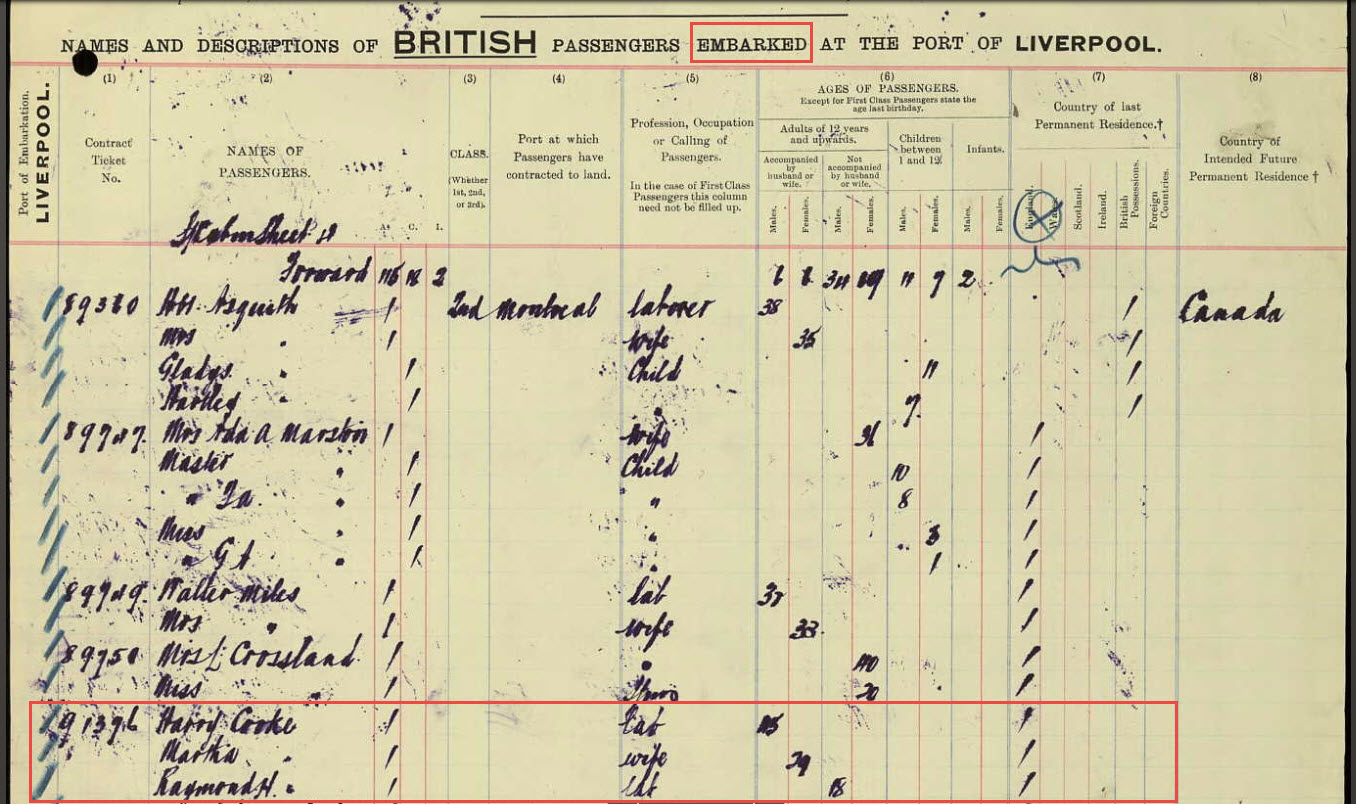
I also spotted this interesting item in the database description. Quoted from the U.K. National Archives website:
“Between 1890 and 1920, among the highest tonnage of ships were leaving British ports bound for North America. Many passengers were emigrants from Britain, Ireland, and Europe. European emigrants bound for America entered the United Kingdom because traveling steerage was less expensive from a British port than from a port in Europe. The shipping companies imposed restrictions on passengers registering; passengers had to have British residency of six weeks to qualify. Many passengers too impatient to qualify for residency changed their names to avoid detection.”
A name change would certainly present a challenge, but it’s very good to know to be on a look out for that situation. This is another example of why it is so important to read the description of the databases you search.
MORE EMIGRATION RECORD COLLECTIONS
A quick search of Ancestry’s card catalog shows emigration collections for Prussia, Switzerland, a few parts of Germany, Jewish refugees from several nations in Europe, and an interesting collection of Dutch emigrants who came to North America with the help of the Canadian and Dutch governments.
Another excellent resource is the FamilySearch Wiki. You can search for the name of the country and the word emigration (with an e) to find out more about your targeted area. I typed in Hungary emigration and found the following information.
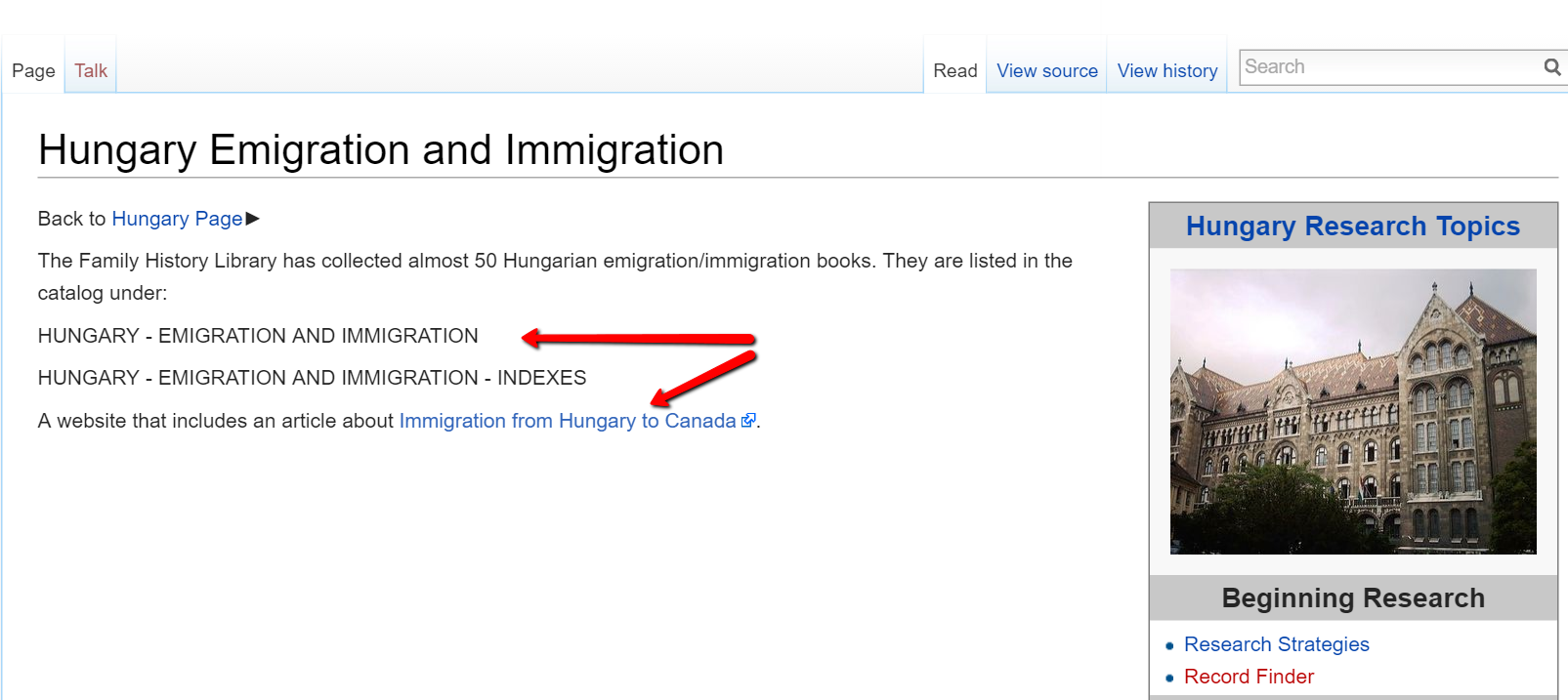
Did your emigrant (or immigrant) ancestor generate records in the country he or she left from as well as the country he or she entered? Remember to check!
MORE GEMS ON IMMIGRATION
by Lisa Cooke | Aug 4, 2016 | 01 What's New, Records & databases
You will all feel a little lucky this week with new and updated genealogical records for Ireland and several states across the U.S. Records from Nevada, Nebraska, Georgia, Pennsylvania, and Minnesota are on the list. Updates to two of the Freedmen’s Bureau record collections will wrap up this week’s records you can dig into.

IRELAND – RECORDS, GUIDES, AND BOOKS
The New England Historical and Genealogical Society is offering access to their Irish resources for FREE for a limited time. So hurry before it ends on August 9th and see what luck you have digging up your Irish ancestors.
You will need to sign-up, but remember, it’s free. Once you have logged on, you will begin your search here.
Many Irish researchers have difficulty finding records because of the destruction of the Public Record Office in 1922. Not only can you browse the records available, but also the subject guides and books for Irish genealogy.
UNITED STATES – PENNSYLVANIA – NATURALIZATION RECORDS
The Chester County, Pennsylvania website has made their naturalization indexes available for the year span of 1798-1935. To search their indexes is free, but there is no name search field. You may have to scan several pages to find the record that may interest you. The database is also available to search from Ancestry.com and allows you to search by name, date of event, and place of origin.
The index of naturalizations include the name of the individual, name of native country, and a date. The original record could hold additional information. You can request a copy of the original record from their webpage. To learn more about that, click here.
UNITED STATES – NEVADA – MARRIAGE & DIVORCE
The most difficult records too find are often those that were created within the last 50 years. Due to the scarcity of recent records, we are pleased to see Ancestry has added a new database titled Nevada, Marriage Certificates, 2002-2015. You can search by name, date, location, and spouses name.
The digital image of the marriage records differs from year to year and location to location, but generally, you will find the couples’ names, ages, date and location of the marriage, and the person who officiated the wedding.
Nevada, Divorce Records, 1968-2015 has recently been updated on Ancestry as well. This index includes nearly half a million divorce records. You can use the index to locate the county the divorce took place, and then contact that county for the original records. You won’t find the reason for divorce in this index, but you can find the county of divorce and the divorce file number that will help locate the further records you want.
UNITED STATES – NEBRASKA – PASSENGER LISTS
A passenger list database for Omaha, Nebraska? Yep, but these are passenger and crew lists of air manifests between the years of 1958-1965. The collection is titled Omaha, Nebraska, Passenger and Crew Manifests of Airplanes, 1958-1965. If your Omaha relative did a lot of air travel, these records may be of interest to you. These records were were recorded on a variety of forms turned over to the Immigration and Naturalization Service. Some details included the name of the airline, type of aircraft, flight number, places of departure and arrival, dates of departure and arrival, full name, age, gender, physical description, military rank (if any), occupation, birthplace, citizen of what country, and residence. For military transports, you may even find the next of kin, relationships, and addresses. Later, manifests may include visa or passport numbers.
UNITED STATES – MINNESOTA – PASSENGER LISTS
The same is true in this database, Minnesota, Passenger and Crew Lists, 1957-1962 at Ancestry. This collection includes both air travel and ships coming into Minnesota ports. The original records were originally digitized by the National Archives and Records Administration. Information you may collect from these digital images include:
- Name
- Age
- Gender
- Ethnicity, nationality or last country of permanent residence
- Destination
- Arrival date
- Port of arrival
- Port of departure
- Ship name
UNITED STATES – GEORGIA – BONDS AND LICENSES
Ancestry has added the Savannah, Georgia, Licenses and Bonds, 1837-1909 database this week. You will find digital images of records from the City of Savannah’s Clerk of Council relating to people and businesses. These records usually include the name of person’s name, occupation, name of business, record date, record place, and subject.
UNITED STATES – FREEDMEN RECORDS
FamilySearch has updated two of their existing collections within the Freedmen Bureau Records. The United States, Freedmen’s Bureau Ration Records,1865-1872 and the United States, Freedmen’s Bureau, Records of the Superintendent of Education and of the Division of Education, 1865-1872 have been able to be browsed for some time. While not all the records have been indexed by name for easy searching, many have. You will want to first run a search by your targeted name. You can browse all the digitized images, but it won’t be easy. The ration records are not filed by county, but by film number. However, if you want to browse the collection of education records, they are searchable by state, then date.
MORE GEMS ON IRISH GENEALOGY
Beginning Irish Genealogy: Tips and FREE Records
A Comprehensive Way to Learn How to Research Irish Genealogy
Irish Genealogy: Find Your Poor Ancestors in Ireland
by Lisa Cooke | Feb 16, 2014 | 01 What's New, Adoption, Beginner, History
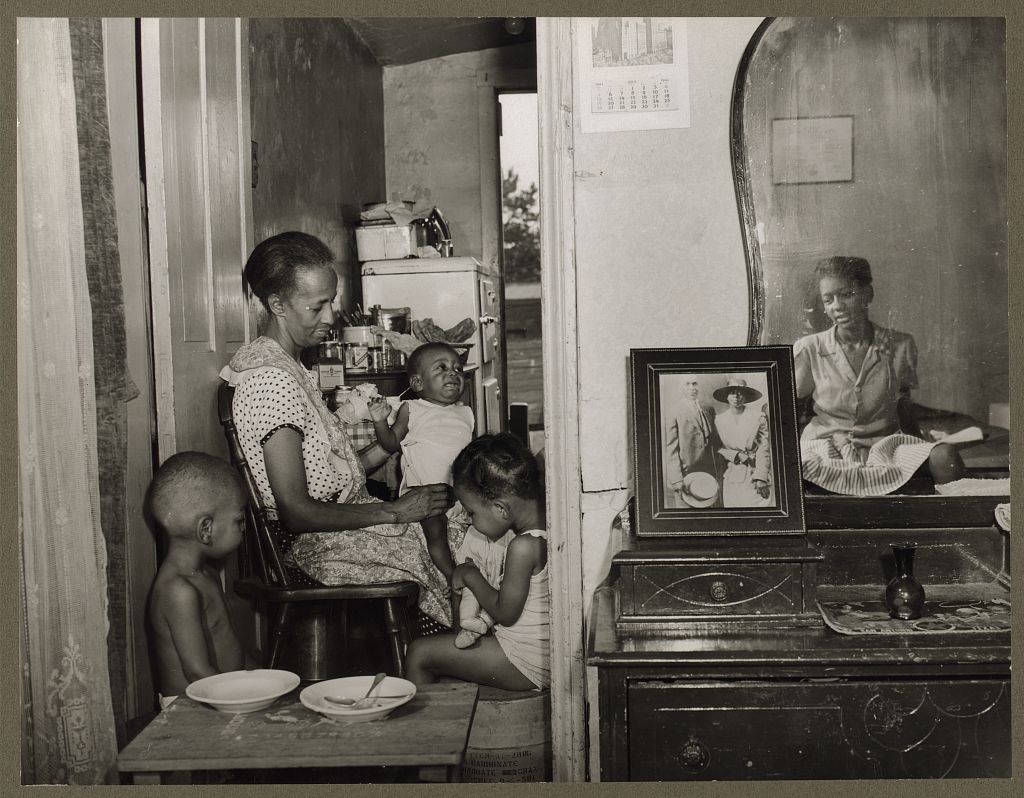
Mrs. Ella Watson, a government charwoman, with three grandchildren and her adopted daughter [reflected in the mirror]. Image from The Gordon Parks Archives in the Library of Congress.
Formal, legal adoption wasn’t common in the U.S. until the late 1800s. (State adoption laws didn’t even exist until after Massachusetts passed the first one in 1851.) Before that, if mom and dad couldn’t take care of a child, a relative, neighbor or friend took that child in, or the child was sent to a county orphanage or poor home. In even earlier days, orphaned or poverty-stricken children were also sold by their towns into indentures.
The Adoption History Project at the University of Oregon has a great timeline of adoption history in the U.S. Check it out to see what was going on when your family member was adopted.
To learn more about adoption and genealogy research, check out these links:
FamilySearch Wiki U.S. Adoption Research
All About Adoption Research by Maureen Taylor
RootsWeb’s Guide to Tracing Family Trees: Adoption



 MyHeritage is known for the technology tools on its site, such as its new Collection Catalog, the Discoveries pages, its DNA matching (click here to upload your raw data for FREE!), automatic record matching in unindexed content such as books, and automatic name translation in the search function.
MyHeritage is known for the technology tools on its site, such as its new Collection Catalog, the Discoveries pages, its DNA matching (click here to upload your raw data for FREE!), automatic record matching in unindexed content such as books, and automatic name translation in the search function.








